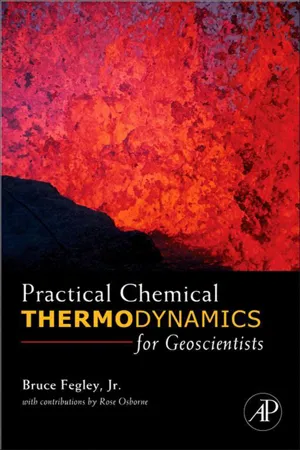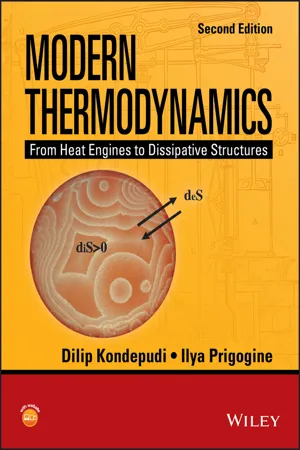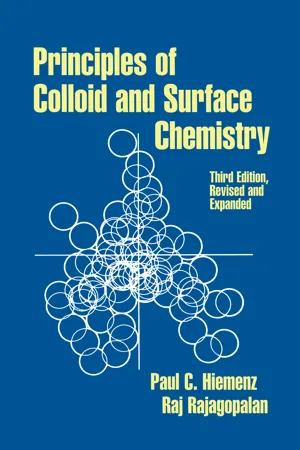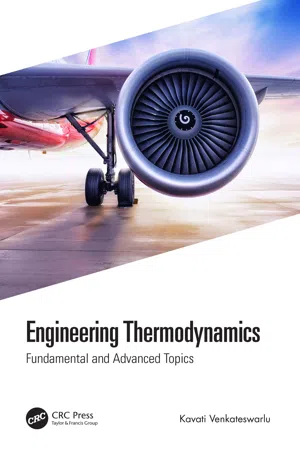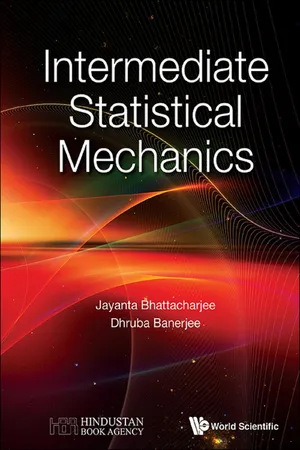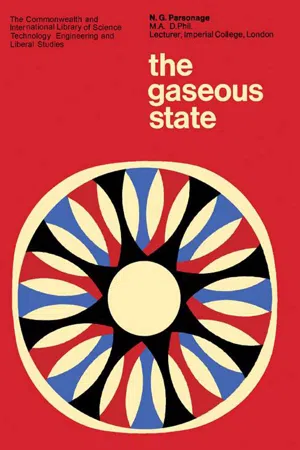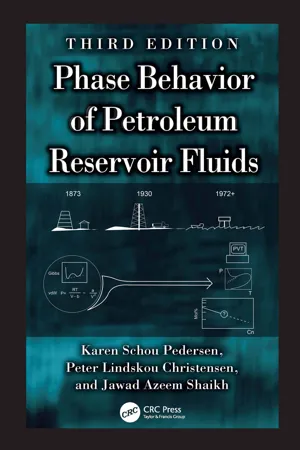Technology & Engineering
Van der Waals Equation
The Van der Waals equation is a modification of the ideal gas law that accounts for the volume occupied by gas molecules and the attractive forces between them. It provides a more accurate representation of real gas behavior, particularly at high pressures and low temperatures. The equation is expressed as (P + a(n/V)^2)(V - nb) = nRT, where P is pressure, V is volume, n is the number of moles, T is temperature, R is the gas constant, and a and b are Van der Waals constants.
Written by Perlego with AI-assistance
Related key terms
Related key terms
1 of 4
Related key terms
1 of 3
8 Key excerpts on "Van der Waals Equation"
- Bruce Fegley Jr.(Author)
- 2012(Publication Date)
- Academic Press(Publisher)
Finally, as we discuss later, reduced-variable plots and tables are also used to estimate thermal properties and fugacity coefficients of gases under P - T conditions where there are no experimental data. In general, these empirical correlations are very useful in cases where the equation of state is unknown. D Van der Waals Equation J. D. van der Waals derived the Van der Waals Equation in his doctoral thesis, written in 1873 when he was 36 years old (see sidebar). An annotated English translation of his thesis (Rowlinson, 2004) was recently republished and is worth reading. The Van der Waals Equation is a major improvement over the ideal gas equation because van der Waals considered the finite volumes of gas atoms or molecules and their interatomic or intermolecular forces. For simplicity, he assumed that atomic or molecular volumes and the forces between the atoms or molecules in a gas are constant. This assumption is only an approximation because the atomic or molecular volumes and the interatomic or intermolecular forces actually depend on the pressure and temperature of a gas. Consequently, the Van der Waals Equation is useful at P - T conditions where the molar volume of a gas is large compared to the volume occupied by the gas atoms or molecules and where the interatomic or intermolecular forces between the gas atoms or molecules are small compared to the thermal energy at the ambient temperature. The Van der Waals Equation is the first real gas equation of state to qualitatively explain the continuity of states, vapor-liquid condensation, and the vapor-liquid critical point of gases (e.g., the explanation given by van der Waals of Andrews [1869] results for CO 2). It is also the prototype for other (more complex) cubic equations of state including the Redlich-Kwong and Peng-Robinson equations and their various modifications (Redlich and Kwong 1949; Holland and Powell 1991; Prausnitz et al. 1999)- eBook - ePub
Modern Thermodynamics
From Heat Engines to Dissipative Structures
- Dilip Kondepudi, Ilya Prigogine(Authors)
- 2014(Publication Date)
- Wiley(Publisher)
If the molecular size and forces are included in the theory, then one refers to it as a theory of a ‘real gas’. As a result of molecular forces, the total internal energy U, the relation between the molar heat capacities C m p and C m V, the equation for adiabatic processes and other thermodynamic quantities will differ from those for the ideal gas. In this section, we shall see how the thermodynamic quantities of a real gas can be obtained from an equation of state that takes molecular size and forces into account. The Van der Waals Equation, which takes into account the intermolecular forces and molecular size, and the critical constants p c, V mc and T c, were introduced in Chapter 1: (6.2.1) in which V m is the molar volume. Since the Van der Waals Equation also has its limitations, other equations have been proposed for gases. Some of the other equations that have been proposed and the corresponding critical constants are as follows: (6.2.2) (6.2.3) (6.2.4) in which a and b are constants similar to the van der Waals constants, which can be related to the critical constants as shown. Another equation that is often used is the virial equation, proposed by Kamerlingh Onnes (1853–1926). It expresses the pressure as a power series in the molar density ρ = N / V : (6.2.5) in which B (T) and C (T) are functions of temperature, called the virial coefficients ; they are experimentally measured and tabulated. For example, it is found that experimental data for the virial coefficient can be approximated by the function B (T) = α – β exp(γ / T), in which α, β and γ are constants and T is the temperature in kelvin. 1 Values of these constants for a few gases are shown in Table 6.1. Table 6.1 An empirical function for the second virial coefficient B(T) = α – β exp (γ /T). Gas α (mL mol −1) β (mL mol −1) γ (K) Range of validity - Tarek Ahmed(Author)
- 2009(Publication Date)
- Gulf Professional Publishing(Publisher)
First assumption . The volume of the gas molecules is insignificant compared to the volume of the container and the distance between the molecules.• Second assumption . There are no attractive or repulsive forces between the molecules or the walls of the container.van der Waals (1873) [61] attempted to eliminate these two assumptions by developing an empirical equation of state for real gases. In his attempt to eliminate the first assumption, van der Waals pointed out that the gas molecules occupy a significant fraction of the volume at higher pressures and proposed that the volume of the molecules, as denoted by the parameter b, be subtracted from the actual molar volume V in Equation 7-1 , to givewhere the parameter b is known as the covolume and is considered to reflect the volume of molecules. The variable V represents the actual volume in cubic feet per 1 mol of gas.To eliminate the second assumption, van der Waals subtracted a corrective term, denoted by a/V2 , from the preceding equation to account for the attractive forces between molecules. In a mathematical form, van der Waals proposed the following expression:(7-2)where p = system pressure, psia T = system temperature, °RR = gas constant, 10.73 psi-ft3 /lb-mol = °RV = volume, ft3 /molThe two parameters a and b are constants characterizing the molecular properties of the individual components. The symbol a is considered a measure of the intermolecular attractive forces between the molecules. Equation 7-2 shows the following important characteristics:1. At low pressures, the volume of the gas phase is large in comparison with the volume of the molecules. The parameter b becomes negligible in comparison with V and the attractive forces term a/V2 becomes insignificant; therefore, the Van der Waals Equation reduces to the ideal gas equation (Equation 7-1- Paul C. Hiemenz, Raj Rajagopalan, Paul C. Hiemenz, Raj Rajagopalan(Authors)
- 2016(Publication Date)
- CRC Press(Publisher)
■ * * *In this section we have examined the three major contributions to what is generally called the van der Waals attraction between molecules. All three originate in dipole-dipole interactions of one sort or another. There are two consequences of this: (a) all show the same functional dependence on the intermolecular separation, and (b) all depend on the same family of molecular parameters, especially dipole moment and polarizability, which are fairly readily available for many simple substances. Many of the materials we encounter in colloid science are not simple, however. Hence we must be on the lookout for other measurable quantities that depend on van der Waals interactions. Example 10.2 introduces one such possibility. We see in Section 10.7 that some other difficulties arise with condensed systems that do not apply to gases.In the next section we take a preliminary look at the way van der Waals attractions scale up for macroscopic (i.e., colloidal) bodies. This will leave us in a better position to look for other measurements from which to estimate the van der Waals parameters.10.5 VAN DER WAALS FORCES BETWEEN LARGE PARTICLES AND OVER LARGE DISTANCESThe interaction between individual molecules obviously plays an important role in determining, for example, the nonideality of gas, as illustrated in Example 10.2 . It is less clear how to apply this insight to dispersed particles in the colloidal size range. If atomic interactions are assumed to be additive, however, then the extension to macroscopic particles is not particularly difficult. Moreover, when dealing with objects larger than atomic dimensions, we also have to consider interactions over appropriately large distances. In the case of the London attraction, forces over large distances show a more rapid decay than indicated by the inverse sixth-power equations derived in Section 10.4 . This is known as (electromagnetic) retardation. We discuss these two important issues in this section before developing the equations for interactions between macroscopic bodies in Section 10.6- eBook - ePub
Engineering Thermodynamics
Fundamental and Advanced Topics
- Kavati Venkateswarlu(Author)
- 2020(Publication Date)
- CRC Press(Publisher)
In reality, there seems to be no gas that behaves like an ideal gas or a perfect gas. The real gases such as oxygen, hydrogen, nitrogen, and air are assumed to behave like a perfect gas at very low pressures or very high temperatures.8.2 Other Equations of State
Van der Waals Equation of State
The kinetic theory of gases, proposed by Clerk Maxwell, forms the basis for establishing the ideal gas equation of state. The ideal gas equation is developed based on certain assumptions as given below:- The molecules of a gas are spaced apart that there is little or no attraction between them.
- The volume occupied by the molecules themselves is quite low compared to the volume of gas.
- Molecules are in random motion, which follows Newton’s law of motion.
- The kinetic energy of the molecules and their momentum are conserved as molecules and walls of the container are perfectly elastic.
The real gases do not obey the assumptions made in the kinetic theory of gases. At very low pressures or very high temperatures, real gas obeys the ideal gas equation as intermolecular attraction and volume occupied by molecules compared to the total volume are not considered at this state. When the pressure increases, intermolecular forces increase and the volume of molecules becomes considerable when compared to that of gas. Thus real gases deviate from the ideal gas equation of state appreciably with an increase in pressure. Van der Waals introduced two correction factors ‘a’ and ‘b’ in the ideal gas equation, first one to account for intermolecular attraction and the second one to account for volume of molecules. The Van der Waals Equation is(8.5)(p +)aν 2(= R Tν − b)the termais called the force of cohesion and b the co-volume. At high pressures, all real gases obey the Van der Waals Equation of state; however, it is not true at all ranges of pressures and temperatures. Table 8.1ν 2 - eBook - ePub
- Jayanta Bhattacharjee, Dhruba Banerjee(Authors)
- 2016(Publication Date)
- WSPC(Publisher)
Eq.(5.1.16) . However, this constraint of going to the thermodynamic limit before obtaining the equation of state makes the virial expansion useless at high densities and hence for studying phase transitions. Phenomenological equations of state such as that due to Van der Waals are consequently very useful.5.3Van der Waals Equation of State
For one mole of a real gas, the equation of state proposed by Van der Waals [see Eq.(5.1.10) ] can be written asClearly P → ∞ as V → b and P → 0 as V → ∞, for a fixed value of T. The intermediate behaviour is not monotonic as extrema exist atorThis gives rise to three roots for V, one of which is smaller than b and hence irrelevant for our purpose. Of the two relevant ones, one is a maximum, the other a minimum. As the temperature is raised, the separation between the maximum and the minimum decreases and if we consider the isotherm at T = Tc , the maximum and the minimum merge and there is only one point at which ∂P/∂V = 0. It is obvious that this limiting situation must be a point of inflection and ∂2 P/∂V2 must be zero. If the molar volume is Vc at T = Tc , then the second derivative of Eq.(5.3.1) yieldsand together with Eq.(5.3.2) at T = Tc and V = Vc (the critical point) we obtainThe above result could also be obtained in a different way. We could have asked for the condition where the two roots of the cubic come together, i.e. Eq.(5.3.2) has the structure (V – α)2 (V – β) = 0. This yields Eq.(5.3.4) once more. Yet another way of arriving at Eq.(5.3.4) is to consider how many values of V yield the same pressure on a given isotherm, i.e., we cast Eq.(5.3.1) itself as a cubic in V for a fixed T and P and determine the three roots.All three roots are real for T < Tc , as it must according to our previous discussion of the maximum, minima and the behaviour at V = b and V = ∞ . For T < Tc , the relation between P and V has got to be monotonic and at T = Tc , when there is an extremum as a point of inflection, the three roots of V must come together and we should have (V – Vc )3 = 0. The condition that the cubic in V has this structure again yields Eq.(5.3.4) . In the light of the above discussion it is fairly obvious what the different isotherms should look like and they are shown in Fig.5.6 - eBook - ePub
The Gaseous State
The Commonwealth and International Library: Chemistry Division
- N. G. Parsonage, Robert Robinson, H.M.N.H. Irving, L. A. K. Staveley(Authors)
- 2013(Publication Date)
- Pergamon(Publisher)
c was to a large extent contrived, since he examined several possible equations of state at about this time and used as his criterion of acceptability that this ratio should be predicted to be ∼3.75. This was approximately the value found for many esters and the other organic substances for which alone good values of the critical constants were available at that time.THE VIRIAL EQUATION
Whereas the van der Waals and the Dieterici equations give good qualitative accounts of the behaviour of imperfect gases, an equation of much more importance quantitatively is the virial equation:(2.22)where B, C, D , etc., which are known as the second, third, fourth, etc., virial coefficients, are functions of temperature but not of pressure.An equation of this form was first used by Kamerlingh Onnes (1912) who arrived at the equation empirically, and did, in fact, omit all the terms in odd powers of 1/V except that in 1/V itself. The expansion was later put on a theoretical basis, and it was found that all the terms in the positive integral powers of 1/V should be included. Furthermore, the theoretical treatment leads to expressions for the virial coefficients in terms of the forces between the molecules. For example, the second virial coefficient is given by(2.23)where ε(r ) = the potential energy of the interaction of two molecules a distance r apart and k = Boltzmann’s constant (= R /N 0 ).This relationship between B and ε(r ) has been the chief source of quantitative information about the forces between molecules, since B can be determined by the measurement of gas imperfection. Because of the form of (2.23 ) it is not possible to express ε explicitly in terms of B . It is necessary to proceed by proposing a form for ε(r ), calculating the values of B - eBook - ePub
- Karen Schou Pedersen, Peter Lindskou Christensen, Jawad Azeem Shaikh(Authors)
- 2024(Publication Date)
- CRC Press(Publisher)
4 Equations of StateDOI: 10.1201/9780429457418-4The majority of calculations of the pressure-volume-temperature (PVT) relation carried out for oil and gas mixtures are based on a cubic equation of state. Cubic equations date back more than 100 years to the famous Van der Waals Equation (van der Waals 1873 ). The most commonly used equations in the petroleum industry today are similar to the Van der Waals Equation, but it took almost a century for the industry to accept this type of equation as a valuable engineering tool. The first cubic equation of state to obtain widespread use was the one presented by Redlich and Kwong (1949) . Soave (1972) and Peng and Robinson (1976 and 1978 ) further developed this equation in the 1970s. In 1982, Peneloux et al. (1982) presented a volume-shift concept for improving liquid density predictions of the two former equations. Computer technology has made it possible, within seconds, to perform millions of multicomponent phase equilibrium and physical property calculations with an equation of state as the thermodynamic basis. This chapter presents some of the most popular cubic equations of state as well as the noncubic PC-SAFT and GERG-2008 equations of state. Chapter 6 describes the application of cubic equations of state in phase equilibrium (flash) calculations, Chapter 8 the derivation of physical properties from cubic equations of state, and Chapter 16 the application of cubic equations of state to mixtures with water and other aqueous components as well as an extension of cubic equations with an association term.4.1 Van der Waals Equation
When deriving the first cubic equation of state, van der Waals used the phase behavior of a pure component as the starting point. Figure 4.1 shows schematically pressure (P) versus molar volume (V) curves for a pure component at various temperatures. At temperatures far above the critical (T1 in Figure 4.1
Index pages curate the most relevant extracts from our library of academic textbooks. They’ve been created using an in-house natural language model (NLM), each adding context and meaning to key research topics.
Explore more topic indexes
Explore more topic indexes
1 of 6
Explore more topic indexes
1 of 4
